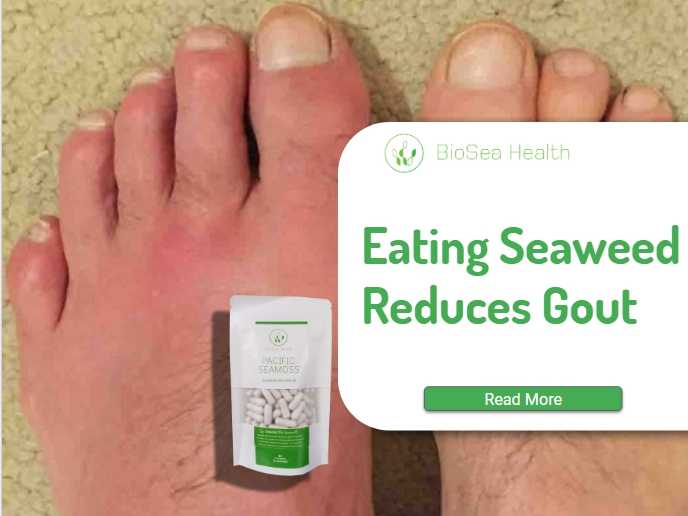In a novel study published in March 2021, a team of Chinese researchers looked at 32,000 men and women and showed that seaweed reduces gout (hyperuricemia or HUA) in men. The association was not shown for women.
What is Gout?
Gout is a common and complex form of arthritis that can affect anyone. It’s characterized by sudden, severe attacks of pain, swelling, redness and tenderness in one or more joints, most often in the big toe.
An attack of gout can occur suddenly, often waking you up in the middle of the night with the sensation that your big toe is on fire. The affected joint is hot, swollen and so tender that even the weight of the bedsheet on it may seem intolerable.
Gout symptoms may come and go, but there are ways to manage symptoms and prevent flares. One of the markers looked at are levels of uric acid, as uric acid is the end product of purine metabolism. Increased production or reduced excretion of serum uric acid level causes hyperuricemia (HUA) and gout [2]. Gout is related to age and BMI and there are many societal behaviours that appear to change incidence and severity of gout.
For the past 30 years, it is known that most patients with HUA are asymptomatic and do not receive treatment. As Zang and the team point out, HUA is the causative agent of gout [3], and is an independent risk factor for cardiovascular events [4, 5], hypertension [6], diabetes [7], cancer [8] and renal disease [9], and independently predicts myocardial infarction and premature death [10].
We know from other animal studies and human trials that seaweed reduces high blood pressure.
Study shows seaweed reduces gout Serum markers
A study of 32,365 adults in Tianjin in China, published in Mar 2021 [1] looked at the food that the men and women ate, the frequency of seaweed eaten and the correlation with hyperuricemia.
Hyperuricemia was defined as serum uric acid levels ≥7.0mg/dL in men and ≥6mg/dL in women.
The prevalence of HUA was 21% in men and 6% in women. Men had higher BMI, more likely to be smokers and drinkers, had elevated cholesterol markers, ate more sweet food and more meat. Compared with females, males were more highly educated, were more likely to be managers, had a higher income, and had a higher prevalence of hypertension, hyperlipidemia, and diabetes
What they found was for men that the more seaweed eaten, the lower the uric acid levels.
Eat more seaweed – it will help reduce gout.
References
- Zhang, T., Wang, Y., Gu, Y., Meng, G., Zhang, Q., Liu, L., Wu, H., Zhang, S., Wang, X., Sun, S., Wang, X., Zhou, M., Jiao, H., Jia, Q., Song, K., Wu, Y., Wu, X. H., & Niu, K. (2021). Title: Relationship between seaweeds consumption and hyperuricemia in general adults: A Population-based Study from the TCLSIH Cohort Study. The British journal of nutrition, 1–31. Advance online publication. https://doi.org/10.1017/S0007114521000891
- Garrel DR, Verdy M, PetitClerc C, Martin C, Brule D, Hamet P. Milk- and soy-protein ingestion: acute effect on serum uric acid concentration. Am J Clin Nutr. 1991;53(3):665-9. Epub 1991/03/01. doi: 10.1093/ajcn/53.3.665. PubMed PM ID: 2000819
- Choi HK, Mount DB, Reginato AM, American College of P, American Physiological S. Pathogenesis of gout. Ann Intern Med. 2005;143(7):499-516. Epub 2005/10/06. doi: 10.7326/0003-4819-143-7-200510040-00009. PubMed PMID: 16204163.
- Hoieggen A, Alderman MH, Kjeldsen SE, Julius S, Devereux RB, De Faire U, et al. The impact of serum uric acid on cardiovascular outcomes in the LIFE study. Kidney international. 2004;65(3):1041-9. doi:10.1111/j.1523-1755.2004.00484.x. PubMed PMID: 14871425.
- Holme I, Aastveit AH, Hammar N, Jungner I, Walldius G. Uric acid and risk of myocardial infarction, stroke and congestive heart failure in 417,734 men and women in the Apolipoprotein MOrtality RISk study (AMORIS). Journal of internal medicine. 2009;266(6):558-70. doi: 10.1111/j.1365-2796.2009.02133.x. PubMed PMID: 19563390.
- Sundstrom J, Sullivan L, D’Agostino RB, Levy D, Kannel WB, Vasan RS. Relations of serum uric acid to longitudinal blood pressure tracking and hypertension incidence. Hypertension. 2005;45(1):28-33. doi: 10.1161/01.HYP.0000150784.92944.9a. PubMed PMID: 15569852.
- Bhole V, Choi JW, Kim SW, de Vera M, Choi H. Serum uric acid levels and the risk of type 2 diabetes: a prospective study. Am J Med. 2010;123(10):957-61.
- Strasak AM, Rapp K, Hilbe W, Oberaigner W, Ruttmann E, Concin H, et al.
Serum uric acid and risk of cancer mortality in a large prospective male cohort. Cancer causes & control : CCC. 2007;18(9):1021-9. doi: 10.1007/s10552-007-9043-3. PubMed PMID: 17665312. - Obermayr RP, Temml C, Gutjahr G, Knechtelsdorfer M, Oberbauer R,
Klauser-Braun R. Elevated uric acid increases the risk for kidney disease. Journal of the American Society of Nephrology : JASN. 2008;19(12):2407-13. doi: 10.1681/ASN.2008010080. PubMed PMID: 18799720; PubMed Central PMCID: PMC2588108. - Fang J, Alderman MH. Serum uric acid and cardiovascular mortality the
NHANES I epidemiologic follow-up study, 1971-1992. National Health and Nutrition Examination Survey. Jama. 2000;283(18):2404-10. doi: 10.1001/jama.283.18.2404. PubMed PMID: 10815083. - Uaratanawong S, Suraamornkul S, Angkeaw S, Uaratanawong R. Prevalence of hyperuricemia in Bangkok population. Clinical rheumatology. 2011;30(7):887-93. doi: 10.1007/s10067-011-1699-0. PubMed PMID: 21302126

